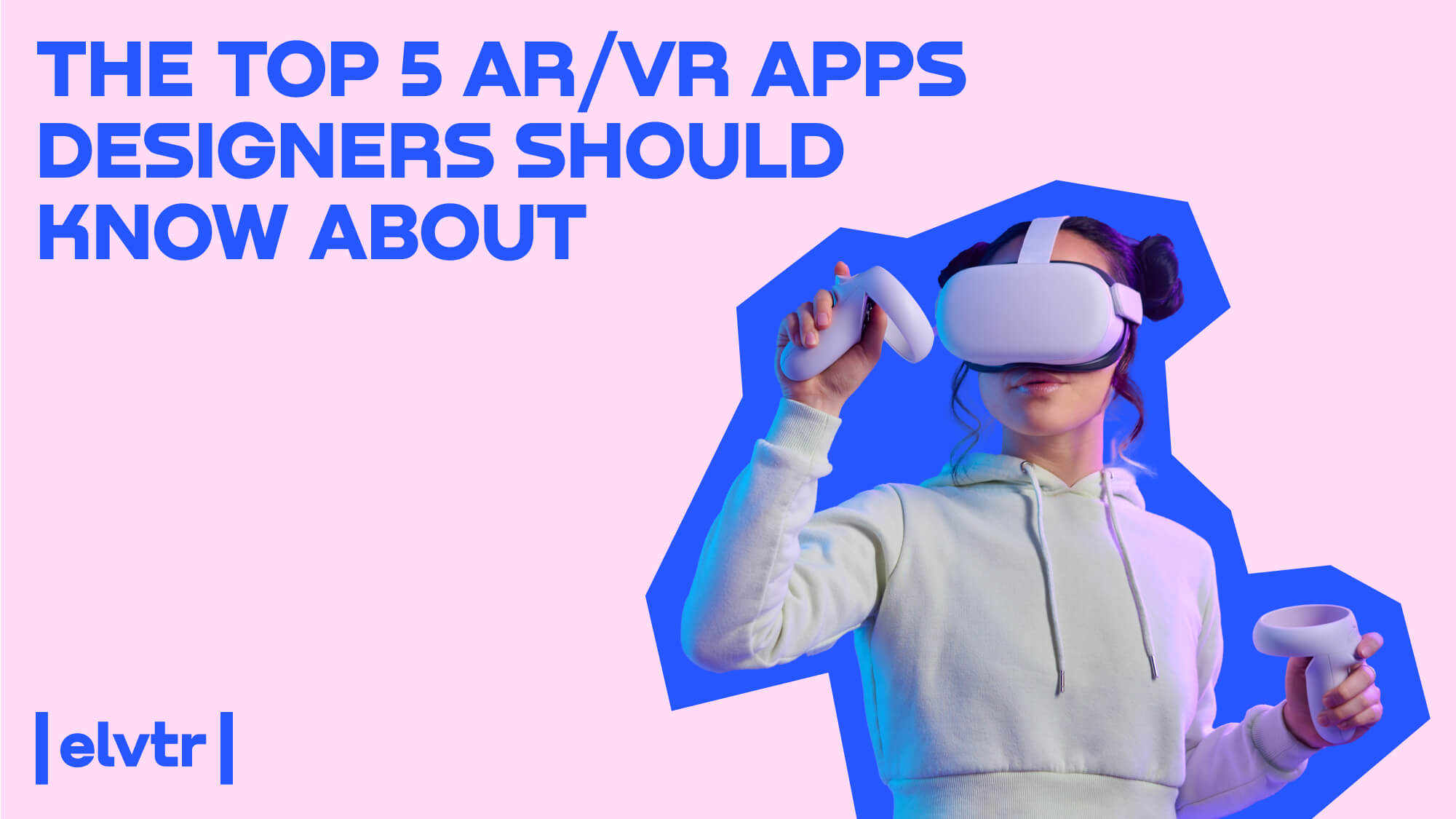- MAIN PAGE
- – elvtr magazine – THE TOP 5 AR/VR APPS DESIGNERS SHOULD KNOW ABOUT
THE TOP 5 AR/VR APPS DESIGNERS SHOULD KNOW ABOUT

Businesses today are incorporating AR and VR beyond just entertainment, using them as innovative communication tools with consumers.
For instance, Kia, the South Korean carmaker, has added a VR experience in its stores, letting customers virtually explore and select their favorite car models. Meanwhile, during a Dallas store launch, IKEA invited customers to utilize their AR app to visualize how furniture and décor might fit in their homes.
While AR/VR software is still emerging, there's already a slew of platforms and tools for creating immersive augmented and virtual reality applications, some even without coding. Let's dive into some of the best tools for crafting AR/VR products.
#1. Unreal Engine
Unreal Engine stands out as a leading real-time 3D creation tool, offering a comprehensive suite for game design, simulations, and visualizations.
Developers can use Unreal Engine to craft digital solutions for platforms like Windows, MacOS, Linux, Xbox, PlayStation, and even mobile devices like iOS and Android, making it appealing for businesses across various sectors.
Unique features that set Unreal Engine apart from other VR and AR tools include:
- Versatile deployment options, supporting everything from Hololens to ARCore to Oculus.
- Superior quality and performance, although mastering its VR design software requires a solid grasp of C++.
- A broad range of applications, from cinema-level special effects to architecture and gaming.
- Regular updates catering to the fast-evolving world of extended reality.
- Free access, though a royalty fee applies for successful games that earn over a million dollars.
Unreal Engine has a learning curve, particularly its interface. But once you're familiar, its capabilities are unmatched. Some renowned products developed using Unreal Engine include Fortnite, PES 2020, Lineage 2: Revolution, Heroes Reborn: Enigma, and PUBG Mobile.
#2. Unity
Unity is a favorite among developers for crafting stellar 2D and 3D games/3D animation for smartphones, desktops, consoles, TV, VR, AR, and web apps. Unity Technologies, the powerhouse behind Unity, is deeply invested in AR and VR, ensuring their tools evolve with industry demands.
Highlights of the Unity software:
- Stunning visuals. Unity software enables the creation of immersive VR experiences suitable for varied hardware specifications, and its Universal Render Pipeline ensures smooth, high-performance VR games.
- Team collaboration. Unity Plastic SCM improves team workflows, essential for VR development.
- Cost-effective plans. While students and individual users can access Unity for free, premium plans start at €1,877/year. But there's a 30-day free trial to test the waters.
From automotive to education and security, industries worldwide are harnessing Unity. Internal stats show 70% of the top 1,000 free mobile apps and games are Unity-built. Some noteworthy mentions include Surgical Anatomy of the Liver, BitGym, and the Louvre-lens mobile tour app.
#3. ARKit
ARKit is Apple's framework designed for crafting augmented reality experiences on iOS devices. Utilizing camera sensors coupled with data from the gyroscope and accelerometer, ARKit evaluates and interprets the user's surroundings for AR visualization.
The framework uses the camera and motion sensors to track movement, identify surfaces, and assess lighting, producing a virtual representation of the real world. One notable feature is its ability to recognize flat horizontal surfaces.
Employing VIO (Visual Inertial Odometry), ARKit positions 3D objects and overlays contextual numerical information. Key ARKit functions encompass SLAM, sensor fusion, lighting condition evaluation, determination of scale, vertical and horizontal plane recognition, and robust, quick motion tracking.
Apple consistently enhances its AR offerings. In 2022, alongside iOS 16 and iPad 16, ARKit received noteworthy updates:
- 4K video. The newest ARKit iteration boasts a full 4K video mode, allowing apps to harness high-resolution imagery.
- Camera settings enhancements. Beyond the 4K feature, other upgrades optimize camera functionality. For example, the Object Capture feature captures multiple images of tangible items, leveraging Photogrammetry algorithms to transform them into lifelike 3D models suitable for AR apps.
- Advanced motion recognition. First seen in ARKit 3, motion capture facilitates the tracking of human body movements, repurposing them for augmented reality inputs. Each version introduces recognition for a broader array of body positions and gestures.
- Enhanced Location Anchors. These are vital for anchoring AR objects to real-world geographic coordinates.
- Multiplayer. Different devices can visualize the same AR environment. Users have the flexibility to pause and revisit a virtual setting, enriching interactive experiences.
All iPhones and iPads running iOS 11 or later support ARKit apps. Apple ARKit is accessible free of charge for those enrolled in the Developer Program (at $99/person).
Industry leaders like IKEA and Amazon are either integrating ARKit into their primary apps or constructing new ones, exclusively harnessing AR for shopping experiences.
#4. ARCore
ARCore, Google's platform for AR product development, harnesses diverse APIs, enabling mobile devices to comprehend and navigate their surroundings and engage with information.
Using the device's camera and inertial sensors, ARCore tracks motion and observes objects from diverse perspectives, pinpointing the dimensions and position of various surfaces. A significant ARCore highlight is its operation without needing extra equipment—just mainstream Android devices like smartphones and tablets.
Other platform advantages include:
- Effortless AR app creation. ARCore streamlines AR app development, allowing developers to prioritize innovative content over technical specifics.
- Cross-platform capabilities. ARCore is compatible with both Android and iOS devices.
- Exceptional accuracy and quality in recognizing surfaces and objects.
The inaugural ARCore version supports devices like the Google Pixel, Pixel XL, Samsung Galaxy S8, S8+, Samsung Galaxy Note 8, Asus Zenfone AR, and LG V30. Google anticipates expanding this list.
Subscription plans begin at $42/month. However, platform usage remains free until app deployment.
Prominent corporations such as Accenture, Samsung Electronics Co, and Siemens AG frequently employ ARCore.
#5. Wikitude
Wikitude is a versatile app tailored for crafting AR prototypes for iOS, Android, and Windows mobile devices, as well as select HUDs (helmets).
Wikitude's comprehensive features include:
- 3D model visualization
- Geo-oriented AR
- Image recognition and tracking, alongside cloud recognition (supporting up to 2 million scans monthly and 20,000 images)
- SLAM (Simultaneous Localization and Mapping) technology, ensuring smooth object tracking and recognition bolstered by instant tracking
- Support for smart glasses
Subscriptions with yearly auto-renewal kick off at €2,490/year.
Trusted by businesses, agencies, and developers across over 180 nations, Wikitude powers over 1 billion app installations, standing out as the premier AR tech ally for pioneering business solutions.
Renowned brands like Jack Daniel's, Marvel, The Washington Post, Nissan, Porsche, Lufthansa Technik, and Walmart have founded their AR applications on Wikitude.

